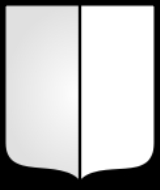
Danish heraldry
Encyclopedia
Danish heraldry has its roots in medieval times when coats of arms first appeared in Europe. Danish heraldry is a branch of the German-Nordic heraldic tradition.
Pairs of buffalo horns (da. vesselhorn) are very common as crests in Scandinavian and German heraldry although virtually unknown in other heraldic traditions. As these horns were often drawn with an open ring at the tip, they have sometimes been altered into elephant trunks or trumpets.
used by King Canute VI
c. 1194. The oldest documentation of the tinctures of the coat of arms are from a depiction in the Armorial Gelre from 1370-86. From the 13th century to the 1420s the national coat of arms used a horned helmet covered with ermine
fur with fans of peafowl feathers. The oldest documentation for the colours dates from c. 1270. Today the coat of arms or derivations of it is used by many state authorities. Only the Folketing
use the coat of arms without the crown.
The National Coat of Arms can be found in the first and fourth quarters of the Danish Royal Coat of Arms (sometimes called the greater national coat of arms). This coat of arms is only used by the royal family.
The Danish military
has a long heraldic tradition. Every regiment and naval vessel have a coat of arms.
 Today most Danish municipalities have their own coat of arms. Until the municipal reform of 2007, in which the counties were abolished, all Danish counties had coats of arms. After the municipal reforms some of the new municipalities have chosen to have new coats of arms designed. The new regions
Today most Danish municipalities have their own coat of arms. Until the municipal reform of 2007, in which the counties were abolished, all Danish counties had coats of arms. After the municipal reforms some of the new municipalities have chosen to have new coats of arms designed. The new regions
are not armigerous but have chosen to use logos instead.
The design of municipal coats of arms can vary but often the designs on medieval seals
have been placed inside a shield. This has produced very complex coats of arms that do not always adhere to the rules of heraldry (e.g. the rule of tincture
); the coat of arms of Århus is an example. There is no tradition for exterior ornaments on Danish municipal coats of arms. The most widespread tincture
is azure (blue) with gules (red) being popular too.
Municipalities display their coats of arms on buildings, on stationery and on traffic sign
s at the limits of the municipality. Armorial banners are not commonly used.
Municipal coats of arms require approval by the National Heraldic Consultant and can be registered at the Danish Patent and Trademark Office. If a municipality chooses to use a logo instead, the approval of the National Heraldic Consultant is not required.
is from 1320. As the assumption of arms is free in Denmark not only noble families have coats of arms and today it is estimated that up to 80 % of Danish private coats of arms are burgher arms.
During the Middle Ages most burghers and peasants had merchant's mark
s or house mark
s that were used for marking ownership and as a means of personal identification. These marks are older than heraldic tradition. They are mostly simple compositions of straight lines suitable for being scratched in wood or other materials. They have a similarity to runes and some marks consist of the initials of the owner. Later merchant's marks also incorporates Latin letters. In the beginning these marks were displayed without a shield but during the Middle Ages it became common to draw them inside a shield. Merchant's marks were used by burghers until the 18th century and for about a century longer by peasants.
Although there are no clear distinction between burgher arms and noble arms, simple coats of arms consisting only of divisions of the field is only used by ancient noble families. Often the designs of burgher arms would resemble the profession of the armiger (priests would prefer crosses and chalices, jurists would prefer scales and swords).
Previously the king tried to introduce the French system of rank helmets but these rules were largely ignored even in royal patents. The open helmet was previously associated with nobility but it is also found on burgher arms as well as there are examples of noble arms with closed helmets. Although it is perfectly legitimate for a burgher family to use an open helmet, as a rule of thumb noble families use open helmets while burgher families used closed ones. Burgher arms follow the same rules as noble arms.
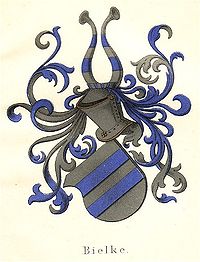 Canting coats of arms have been popular in Danish heraldry for a long time; examples include a man with a tree for Holzmann (lit. "wood-man"), a troll for the Trolle family and a unicorn for Langhorn (lit. "long-horn").
Canting coats of arms have been popular in Danish heraldry for a long time; examples include a man with a tree for Holzmann (lit. "wood-man"), a troll for the Trolle family and a unicorn for Langhorn (lit. "long-horn").
Conversely some ancient noble families have coat of arms older than their family names and took a name based on their armorial bearings, for instance the Panter family (named after the heraldic panther in their arms).
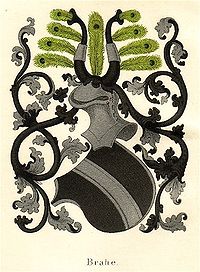 While the arms of ancient noble families often are very simple designs (e.g. sable a pale argent for the Brahe family) the arms of new noble families who got their status by royal patent are often very complex and ignores basic rules for tincture and drawing. At many times these newly created arms were equipped with several helmets and crests giving the false impression that the armiger had many notable ancestors. The heraldic achievement from this period has been criticised by several writers as a symbol of heraldic decadence.
While the arms of ancient noble families often are very simple designs (e.g. sable a pale argent for the Brahe family) the arms of new noble families who got their status by royal patent are often very complex and ignores basic rules for tincture and drawing. At many times these newly created arms were equipped with several helmets and crests giving the false impression that the armiger had many notable ancestors. The heraldic achievement from this period has been criticised by several writers as a symbol of heraldic decadence.
Today modern Danish heraldry has abandoned the overly complex arms of previous periods and has returned to a more simple style closer to the medieval.
Apart from those coats of arms assumed by people with an interest in heraldry, many modern Danish coats of arms are composed for recipients of the grand cross of the Order of the Dannebrog
who are entitled to hang their coats of arms in the Frederiksborg Palace
church. There is also a tradition for masonic heraldry, utilising masonic symbols like the square and compas as charges. As noble titles are no longer conferred, noble arms are no longer composed.
Danish heraldry follows the German-Nordic tradition. As opposed to Gallo-British heraldry, where each individual of a family has his own coat of arms, a Danish coat of arms usually is the same for an entire family as there is no tradition of cadency marks. A specific trait of German-Nordic heraldry is that the crest usually repeats the design of the shield. Traditionally crests are not used alone. Likewise there is no tradition of badges.
There is a system of coronets denoting noble rank; supporters also are reserved for high nobility.
The National Heraldic Consultant is an officer under the Danish National Archive. His job is to ensure that official coats of arms adhere to the rules of heraldry and to approve municipal coats of arms. He has no jurisdiction over private coats of arms.
Private coats of arms are not regulated and need no official sanction. Private coats of arms can be used as trademarks and thus be protected from other commercial use. Specific renditions of coats of arms are protected by copyright law.
Tinctures
The tinctures and metals used in Danish heraldry are the same as in other European heraldic traditions. The tinctures gules, azure and sable are most common with vert and purpure being less common and furs very rare.| Tinctures Tincture (heraldry) In heraldry, tinctures are the colours used to emblazon a coat of arms. These can be divided into several categories including light tinctures called metals, dark tinctures called colours, nonstandard colours called stains, furs, and "proper". A charge tinctured proper is coloured as it would be... |
Colours / Farver | |||||
|---|---|---|---|---|---|---|
| Escutcheons |  |
 |
 |
 |
 |
 |
| English | Argent | Azure | Gules | Vert | Purpure | Sable |
| Danish | Hvid / sølv | Blå | Rød | Grøn | Purpur | Sort |
| Metals / Metaller | Furs / Pelsværk | |||||
| Escutcheons |  |
 |
 |
 |
 |
|
| English | Or | Argent | Ermine | Vair | Counter-ermine | |
| Danish | Gul / guld | Hvid / sølv | Hermelin | Gråværk | Kontrahermelin | |
Charges
Danish heraldry use the same divisions as are common in other heraldic traditions. The most simple charge is the division of the field by a straight line. These divisions are called skjolddelinger (lit. divisions of the shield) in Danish. Ordinaries are called heroldsfigurer (lit. herold figures) in Danish.| Divisions Division of the field In heraldry, the field of a shield can be divided into more than one area of different tinctures, usually following the lines of one of the ordinaries and carrying its name... |
 |
 |
 |
 |
 |
|---|---|---|---|---|---|
| English | Party per fess | Party per pale | Party per bend sinister | Quarterly | Quarterly with a heart |
| Dansk | Tværdelt / vandret delt | Spaltet / lodret delt | Tværdelt fra venstre | Kvadreret | Kvadreret med hjerteskjold |
| Ordinaries Ordinary (heraldry) In heraldry, an ordinary is a simple geometrical figure, bounded by straight lines and running from side to side or top to bottom of the shield. There are also some geometric charges known as subordinaries, which have been given lesser status by some heraldic writers, though most have been in use... / Heroldsfigurer |
 |
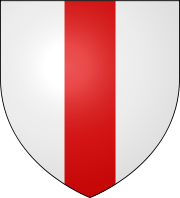 |
 |
 |
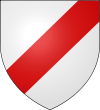 |
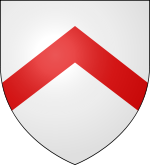 |
|---|---|---|---|---|---|---|
| English | Chief | Pale | Fess | Bend | Bend sinister | Chevron |
| Dansk | Skjoldhoved | Pæl | Bjælke | Skråbjælke | Venstreskråbjælke | Sparre |
| Ordinaries / Heroldsfigurer |
.svg.png) |
.svg.png) |
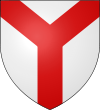 |
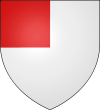 |
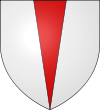 |
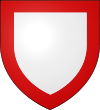 |
| English | Cross | Saltire | Pall | Canton | Pile | Bordure |
| Dansk | Kors | Andreaskors | Gaffelkors | Frikvart | Kile | Bord / bræmme |
| Variations Variation of the field In heraldry, variations of the field are any of a number of ways that a field may be covered with a pattern, rather than a flat tincture or a simple division of the field.- Patterning with ordinaries and subordinaries :... |
 |
 |
 |
 |
 |
 |
 |
 |
|---|---|---|---|---|---|---|---|---|
| English | Barry (of eight) | Paly (of eight) | Bendy (of eight) | Chevronny | Chequy | Lozengy | Gyronny | Fretty |
| Dansk | (Otte gange) tværdelt | (Otte gange) spaltet | (Otte gange) skrådelt | Sparredelt | Skaktavl | Skråtavl | Geret | Fletværk |
Pairs of buffalo horns (da. vesselhorn) are very common as crests in Scandinavian and German heraldry although virtually unknown in other heraldic traditions. As these horns were often drawn with an open ring at the tip, they have sometimes been altered into elephant trunks or trumpets.
State heraldry
The National Coat of Arms of Denmark consists of three crowned blue lions accompanied by nine red hearts, all in a golden shield. The national coat of arms was originally the coat of arms of the royal family but by time it became associated with the Danish territory. The oldest known depiction of the insignia dates from a sealSeal (device)
A seal can be a figure impressed in wax, clay, or some other medium, or embossed on paper, with the purpose of authenticating a document ; but the term can also mean the device for making such impressions, being essentially a mould with the mirror image of the design carved in sunken- relief or...
used by King Canute VI
Canute VI of Denmark
Canute VI was King of Denmark . Canute VI was the eldest son of King Valdemar I and Sophia of Polotsk.-Life:...
c. 1194. The oldest documentation of the tinctures of the coat of arms are from a depiction in the Armorial Gelre from 1370-86. From the 13th century to the 1420s the national coat of arms used a horned helmet covered with ermine
Ermine
Ermine has several uses:* A common name for the stoat * The white fur and black tail end of this animal, which is historically worn by and associated with royalty and high officials...
fur with fans of peafowl feathers. The oldest documentation for the colours dates from c. 1270. Today the coat of arms or derivations of it is used by many state authorities. Only the Folketing
Folketing
The Folketing , is the national parliament of Denmark. The name literally means "People's thing"—that is, the people's governing assembly. It is located in Christiansborg Palace, on the islet of Slotsholmen in central Copenhagen....
use the coat of arms without the crown.
The National Coat of Arms can be found in the first and fourth quarters of the Danish Royal Coat of Arms (sometimes called the greater national coat of arms). This coat of arms is only used by the royal family.
The Danish military
Military of Denmark
The armed forces of the Kingdom of Denmark, known as the Danish Defence is charged with the defence of the Kingdom of Denmark.The Chief of Defence is the head of the Danish Armed Forces, and is head of the Defence Command which is managed by the Ministry of Defence. Constitutionally, the...
has a long heraldic tradition. Every regiment and naval vessel have a coat of arms.
Municipal heraldry

Regions of Denmark
The Regions of Denmark were created as part of the 2007 Danish Municipal Reform. The five regions replace the former sixteen counties . At the same time, the number of municipalities was cut from 270 to 98. The reform was made effective on 1 January 2007.- List of regions :The names of the regions...
are not armigerous but have chosen to use logos instead.
The design of municipal coats of arms can vary but often the designs on medieval seals
Seal (device)
A seal can be a figure impressed in wax, clay, or some other medium, or embossed on paper, with the purpose of authenticating a document ; but the term can also mean the device for making such impressions, being essentially a mould with the mirror image of the design carved in sunken- relief or...
have been placed inside a shield. This has produced very complex coats of arms that do not always adhere to the rules of heraldry (e.g. the rule of tincture
Rule of tincture
The first rule of heraldic design is the rule of tincture: metal should not be put on metal, nor colour on colour . This means that Or and argent may not be placed on each other; nor may any of the colours be placed on another colour...
); the coat of arms of Århus is an example. There is no tradition for exterior ornaments on Danish municipal coats of arms. The most widespread tincture
Tincture (heraldry)
In heraldry, tinctures are the colours used to emblazon a coat of arms. These can be divided into several categories including light tinctures called metals, dark tinctures called colours, nonstandard colours called stains, furs, and "proper". A charge tinctured proper is coloured as it would be...
is azure (blue) with gules (red) being popular too.
Municipalities display their coats of arms on buildings, on stationery and on traffic sign
Traffic sign
Traffic signs or road signs are signs erected at the side of roads to provide information to road users. With traffic volumes increasing over the last eight decades, many countries have adopted pictorial signs or otherwise simplified and standardized their signs to facilitate international travel...
s at the limits of the municipality. Armorial banners are not commonly used.
Municipal coats of arms require approval by the National Heraldic Consultant and can be registered at the Danish Patent and Trademark Office. If a municipality chooses to use a logo instead, the approval of the National Heraldic Consultant is not required.
Personal heraldry
Heraldry first appeared among the warrior class and thus became linked to nobility. But other groups of society quickly took up the heraldic tradition. The first Scandinavian burgher armsBurgher arms
Burgher arms are coats of arms of commoners in heraldry of the European continent, and, by definition, the term is alien to British heraldry....
is from 1320. As the assumption of arms is free in Denmark not only noble families have coats of arms and today it is estimated that up to 80 % of Danish private coats of arms are burgher arms.
During the Middle Ages most burghers and peasants had merchant's mark
Merchant's mark
Merchants' marks are as old as the sealings of the third millennium BCE found in Sumer that originated in the Indus Valley. Impressions of cloth, strings and other packing material on the reverse of tags with seal impressions indicate...
s or house mark
House mark
A House mark is a graphical figure used as a mark of recognition, that consists of simple lines with no fixed colors. A house mark is similar in appearance to pictograms and many logos....
s that were used for marking ownership and as a means of personal identification. These marks are older than heraldic tradition. They are mostly simple compositions of straight lines suitable for being scratched in wood or other materials. They have a similarity to runes and some marks consist of the initials of the owner. Later merchant's marks also incorporates Latin letters. In the beginning these marks were displayed without a shield but during the Middle Ages it became common to draw them inside a shield. Merchant's marks were used by burghers until the 18th century and for about a century longer by peasants.
Although there are no clear distinction between burgher arms and noble arms, simple coats of arms consisting only of divisions of the field is only used by ancient noble families. Often the designs of burgher arms would resemble the profession of the armiger (priests would prefer crosses and chalices, jurists would prefer scales and swords).
Previously the king tried to introduce the French system of rank helmets but these rules were largely ignored even in royal patents. The open helmet was previously associated with nobility but it is also found on burgher arms as well as there are examples of noble arms with closed helmets. Although it is perfectly legitimate for a burgher family to use an open helmet, as a rule of thumb noble families use open helmets while burgher families used closed ones. Burgher arms follow the same rules as noble arms.

Conversely some ancient noble families have coat of arms older than their family names and took a name based on their armorial bearings, for instance the Panter family (named after the heraldic panther in their arms).

Today modern Danish heraldry has abandoned the overly complex arms of previous periods and has returned to a more simple style closer to the medieval.
Apart from those coats of arms assumed by people with an interest in heraldry, many modern Danish coats of arms are composed for recipients of the grand cross of the Order of the Dannebrog
Order of the Dannebrog
The Order of the Dannebrog is an Order of Denmark, instituted in 1671 by Christian V. It resulted from a move in 1660 to break the absolutism of the nobility. The Order was only to comprise 50 noble Knights in one class plus the Master of the Order, i.e. the Danish monarch, and his sons...
who are entitled to hang their coats of arms in the Frederiksborg Palace
Frederiksborg Palace
Frederiksborg castle is a castle in Hillerød, Denmark. It was built as a royal residence for King Christian IV, and is now known as The Museum of National History. The current building replaced a previous castle erected by Frederick II, and is the largest Renaissance palace in Scandinavia...
church. There is also a tradition for masonic heraldry, utilising masonic symbols like the square and compas as charges. As noble titles are no longer conferred, noble arms are no longer composed.
Danish heraldry follows the German-Nordic tradition. As opposed to Gallo-British heraldry, where each individual of a family has his own coat of arms, a Danish coat of arms usually is the same for an entire family as there is no tradition of cadency marks. A specific trait of German-Nordic heraldry is that the crest usually repeats the design of the shield. Traditionally crests are not used alone. Likewise there is no tradition of badges.
There is a system of coronets denoting noble rank; supporters also are reserved for high nobility.
Regulation
Official Danish coats of arms are specially protected by Danish law. In general they may only be used in official duties by offices of state and municipalities. The unlawful use of an official coat of arms or other official insignia is a criminal offence under section 132 of the Danish penal code.The National Heraldic Consultant is an officer under the Danish National Archive. His job is to ensure that official coats of arms adhere to the rules of heraldry and to approve municipal coats of arms. He has no jurisdiction over private coats of arms.
Private coats of arms are not regulated and need no official sanction. Private coats of arms can be used as trademarks and thus be protected from other commercial use. Specific renditions of coats of arms are protected by copyright law.

